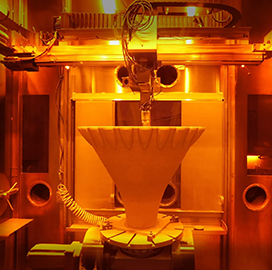NASA worked with Elementum 3D and RPM Innovations to build and test a rocket engine nozzle from weldable aluminum using additive manufacturing.
The 3D printing experiment shows promise in the creation of aluminum-based rocket components, whose lightweight, high-strength and high-density features would allow for more payloads to be carried during deep space missions, NASA said Thursday.
The aluminum engine nozzle is part of the agency’s Reactive Additive Manufacturing for the Fourth Industrial Revolution project. Scientists developed a new aluminum variant and employed RPMI’s laser powder directed energy deposition, or LP-DED technology to modify Elementum’s powder used to build the nozzle as a single piece.
Hot fire tests were conducted at Marshall Space Flight Center in Huntsville, Alabama.
“This test series marks a significant milestone for the nozzle,” RAMFIRE Principal Investigator Paul Gradl said. “After putting the nozzle through the paces of a demanding hot-fire test series, we’ve demonstrated the nozzle can survive the thermal, structural, and pressure loads for a lunar lander scale engine.”
NASA and its private sector partners will share their LP-DED additive manufacturing process to academic institutions and commercial stakeholders. The novel aluminum is already being examined by aerospace companies as a potential ingredient for satellites and related technologies.





